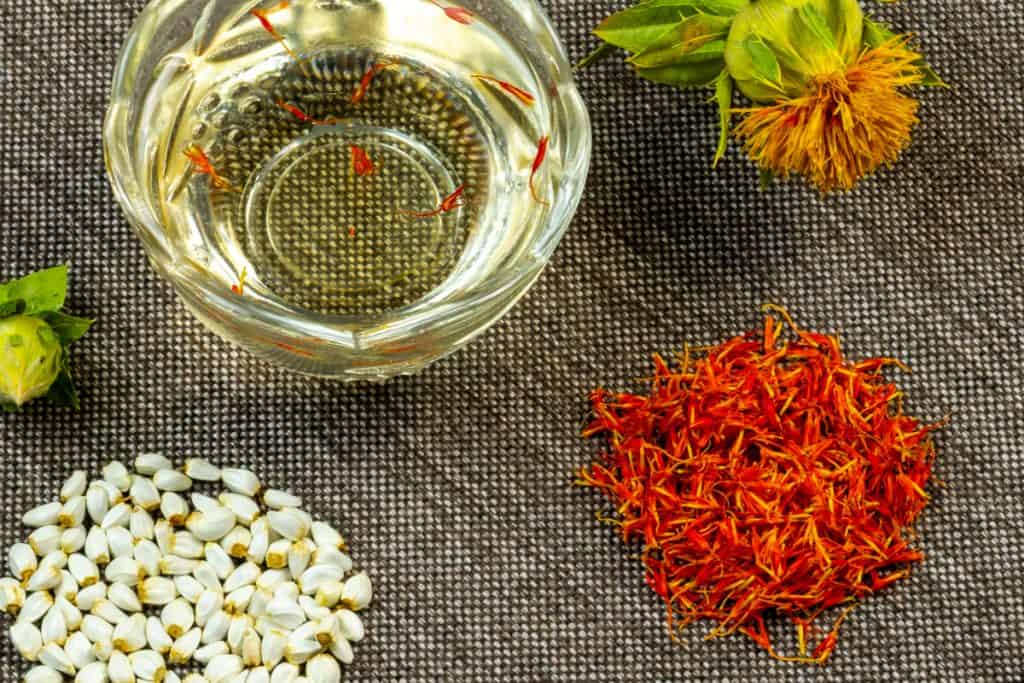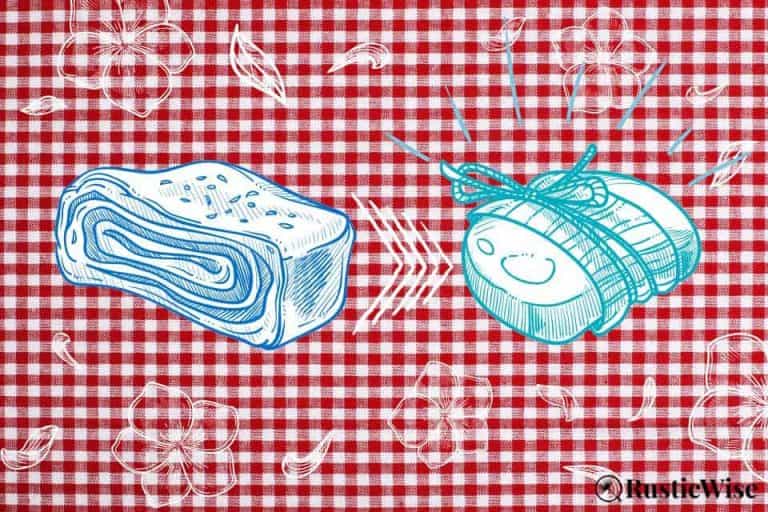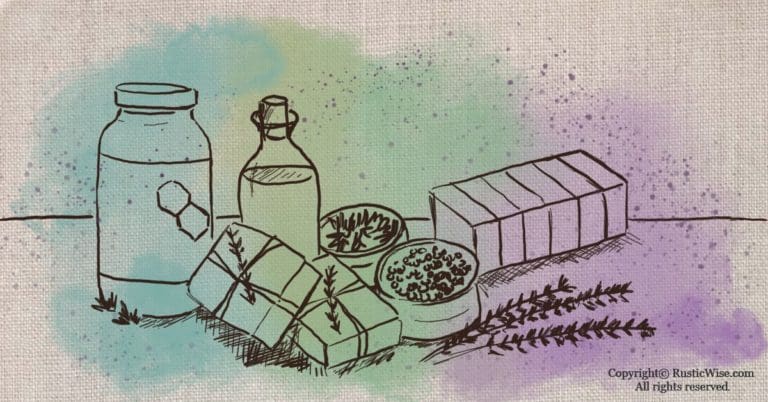Safflower Oil Soap Recipe: A Delight for Skin and Hair
While we often crown olive oil as one of the most highly nourishing oils for skin, safflower oil is no slouch. If you’re looking to add an affordable oil to your next batch of homemade soap with moisturizing and skin smoothing properties, check out our nourishing safflower oil soap recipe below.
Readily available and packed with vitamin E, safflower oil offers many benefits for both skin and hair.
Read on to learn more about using safflower oil in cold process or hot process soap, and why you don’t want to use too much. Check out a recipe for a nourishing shampoo bar featuring safflower, plus other ways to use this moisturizing oil for hair and skin.
A closer look at safflower oil
The safflower (Carthamus tinctoris) is an annual flowering plant that’s native to Africa, Asia, India, and parts of the Middle East. The dried flowers resemble small thistles, and come in a variety of colors: red, orange, yellow, and white. A reddish-hued dye for fabrics was once a popular byproduct of safflower blooms.¹
Safflower oil comes from the pressed seeds of the plant. We use this oil for many applications, including culinary purposes and as an ingredient for skincare products, hair treatments, and soaps. It’s a coveted cooking oil as it’s high in vitamin E and polyunsaturated fats.
Is safflower oil the same as sunflower oil?
These two similarly named oils are often confused, and no, they are not the same. The main difference is that the oils are derived from different plants, with sunflower oil derived from the oil of sunflower seeds (a large blossoming flower with hard-shelled seeds), and safflower oil coming from the oil of safflower seeds (a small thistle-like plant).
Both oils are unsaturated fats. The two oils come in three varieties: linoleic (low oleic), mid oleic, and high oleic. While we often use the two oils interchangeably in cooking, and as substitutes in soap making, they aren’t exact matches.
Tip: If you’re making a bar of soap, run your recipe by in a lye calculator first. Sunflower and safflower oils have slightly different fatty acid content. Both high oleic safflower and sunflower oil have the same SAP value for sodium hydroxide lye (0.135), but have different SAP values for potassium hydroxide lye.

Credit: Yay Images
Is safflower oil good for soap making?
Yes, safflower oil is a good soap making oil when used in smaller quantities (between 5 and 10 percent), and when combined with harder oils. Soap makers like to use safflower oil for its moisturizing and conditioning properties.
Plus, it’s one of the more affordable oils for soap making that’s fairly easy to find at most grocery stores or soap suppliers.
When buying a bottle of safflower oil, look for high oleic varieties which have a longer shelf life than linoleic (low oleic) varieties. This helps prevent rancidity in finished soap and those awful dreaded orange spots.
Look for bottles labelled as all natural, expeller pressed, or cold pressed. And stick with organic if you can!
Tip: Most varieties of safflower oil go rancid quickly and have a short shelf life of less than one year (up to two years if properly stored). To extend the shelf life of safflower oil, store in a cool, dry, dark place. Try refrigerating it once it’s opened. You could also add a bit of vitamin E (tocopherol) to minimize oxidation.
Properties of safflower oil in soap making
With a pale, straw-like color, safflower oil is lightweight and readily absorbed by the skin. It has a neutral odor, which makes it easy to work with when making a batch of soap or other homemade skincare products.
Safflower oil is similar to sunflower oil, canola oil, and olive oil. As it’s more affordable than higher grades of olive oil, we often use safflower oil as a substitute for some soap recipes.
On its own, a pure safflower oil soap recipe would take a long time to reach trace. Therefore, it’s best to combine with harder oils for a better and longer lasting bar of soap.
Other uses of safflower in soap:
- Sprinkle dried safflower petals as a decorative element and finishing touch.
- Add ground safflower powder as a natural colorant to provide a golden color to soap.
Keep in mind that regular safflower oil (high in linoleic fatty acids) is different from high oleic safflower oil.
Take a look at the key differences of the two varieties and their soap making properties.
Table: Properties of Regular Safflower (Linoleic) Oil vs. High Oleic Safflower Oil for Soap
| Safflower Oil (Regular, or Linoleic) | Safflower Oil (High Oleic) | |
|---|---|---|
| Hardness | 7 | 7 |
| Cleansing | 0 | 0 |
| Conditioning | 90 | 92 |
| Bubbly lather | 0 | 0 |
| Creamy lather | 7 | 7 |
| Lauric acid | 0 | 0 |
| Myristic acid | 0 | 0 |
| Palmitic | 7 | 5 |
| Stearic | 0 | 2 |
| Ricinoleic | 0 | 0 |
| Oleic | 15 | 77 |
| Linoleic | 75 (this causes soap to go rancid quickly) | 15 |
| Linolenic | 0 | 0 |
| NaOH SAP Value | 0.137 | 0.135 |
| KOH SAP Value | 0.192 | 0.19 |
How to tell if your oil is high oleic
Sometimes you won’t find a bottle of oil labelled clearly as “high oleic.” In that case, a glance at the nutritional label should tell you whether the oil is high in oleic fatty acids.
High oleic oils are higher in monounsaturated fats. Check the label—the contents of monounsaturated fats should be higher than others. Most bottles labelled as high oleic contain roughly 70 percent high oleic acids.² High oleic oils are better for cooking at higher temperatures and enjoy a longer shelf life.
Conversely, “regular” bottles of safflower oil will be higher in polyunsaturated fatty acids. These polyunsaturated fats consist mainly of linoleic and linolenic acids—two types of fatty acids that cause rancidity in oils and soap as they break down quickly during storage and when heated. Regular or linoleic safflower oil contains around 20 percent oleic acids.²
Somewhere in the middle lies mid-oleic oils, with a composition of about 50–65 percent oleic acids.²

Credit: Deposit Photos
Benefits of safflower oil for skin and hair
Add safflower oil to your list of skin-friendly nourishing oils. Rich in vitamin E, oil from safflower is made primarily of oleic and linoleic fatty acids.
In skincare, linoleic acid acts as an emollient and a thickener—it works to soothe skin.
Oleic acid is highly moisturizing (it’s the main fatty acid in olive oil) and is perfect for applying to dry skin.
Safflower oil soap recipe for a conditioning shampoo bar
Here’s a shampoo bar featuring safflower oil which you can make using the cold process method. It’s ultra conditioning, great for those with dry hair or dry scalp.
Safflower oil and olive oil bring plenty of mild conditioning properties—perfect for sensitive skin. Coconut oil is great for cleansing and big fluffy bubbles. Palm oil adds hardness and provides a stable lather. A dose of shea butter lends a silky feel to your shampoo bar.
If you’re new to soap making, please read up on lye safety and ensure you gather all proper soap making supplies and prepare your work area first!
Safflower Oil Soap Recipe: Nourishing Shampoo Bar
Yield: Approximately 3 pounds of soap
Supplies:
- Digital kitchen scale
- Thermometer (digital, infrared, or candy thermometer)
- Immersion blender (stick blender)
- Stainless steel saucepan for melting the solid oils
- A large bowl for measuring the liquid oils into
- Heat-safe jug for the lye solution
- Rubber spatula for stirring and scraping
- Loaf mold
- Safety gear (goggles and gloves)
Ingredients
Lye solution:
- 11.9 ounces of distilled water
- 4.4 ounces lye (sodium hydroxide)
Hard oils:
- 8 ounces coconut oil (76 degree)
- 4.8 ounces palm oil
- 6.4 ounces shea butter
Liquid oils:
- 6.4 ounces olive oil
- 3.2 ounces safflower oil (high oleic)
- 3.2 ounces castor oil
Essential oils:
- 1.5 ounce of of lavender essential oil (or another EO of your choice)
- Prepare the lye mixture. Put your safety gear on and prepare your work area! Measure the distilled water and add to a heat-safe jug. Measure the sodium hydroxide and slowly add to water. Allow the lye mixture to cool.
- Measure and melt hard oils. While you’re waiting for your lye solution to cool, heat the hard oils in a non-reactive saucepan until melted, then measure and add liquid oils until well combined.
- Bring to trace. Once the lye mixture has cooled and is of similar temperature to the combined oils, carefully add the lye to the oils. Use an immersion blender (stick blender) to combine the soap batter until it thickens and turns opaque (reaches trace).
- Pour into mold. Pour the soap batter into a prepared mold.
- Set and cure. Allow the soap batter to cool thoroughly and harden (at least 24 hours). If soap has hardened, unmold and cut into bars. If bars are too soft, allow it to set for several more days. Let the soap bars cure for 3 to 4 weeks in a well-ventilated room. You’ll get a longer lasting bar this way.
Other ways to use safflower oil for skin and hair
Besides adding safflower oil to your favorite soap or shampoo recipe, you can also use it directly on your skin or hair.
Note: Please ensure you’re using pure safflower oil (food-grade) on your skin and hair, preferably organic—this form of oil is safe to use undiluted directly on skin and hair. Don’t confuse this with safflower essential oil which is a concentrated oil that you must dilute with a carrier oil.
Dry ends hair treatment
You can apply this oil easily at home by either mixing a few drops onto the ends of dry hair strands before bedtime. Leave in overnight.
Scalp treatment
If you have dry scalp or dandruff, apply a few drops directly to the scalp and massage in. Use a comb to disperse the oil throughout your hair. Leave in for 30–60 minutes before shampooing out. This not only conditions your strands but also improves scalp health by encouraging blood circulation.
Soothe eczema
The linoleic fatty acids in safflower, along with the vitamin E, help soothe itchy skin and prevent flaking. Apply a thin layer of safflower oil directly onto eczema patches.
Safflower spot treatment
The noncomedogenic properties in safflower mean you don’t need to worry about it clogging your pores. The anti-inflammatory properties help calm acne flareups. Apply a thin layer directly onto problem areas and leave on overnight.
Related questions
Is safflower oil edible?
Yes, safflower oil is edible. Safflower oil is a type of cooking oil that is extracted from the seeds of a safflower plant. It’s a great option to use for cooking and frying and is one of the most popular and healthy vegetable oils available! It contains a high amount of monounsaturated fat and is high in vitamin E.
It has a light and neutral taste. Use it for cooking, or try drizzling on your favorite foods. You can use it as a salad dressing or as a dip for bread and other savory foods. The great thing is that the high oleic variety of safflower oil doesn’t go rancid as quickly as other oils.
Can you use sunflower oil in soap?
Sunflower oil is a popular soft oil used to make soap. It has a neutral scent and has many similarities to safflower oil. Sunflower oil is very moisturizing and contains high levels of vitamin E. If you are making cold process soap, look for high oleic varieties which are more stable and have a longer shelf life.
New to making soap? 🧼❓
👉We have a fantastic overview on the whole soapmaking process here: read our Timeless Guide To Soapmaking.
If you would like to see our soapmaking posts organized by topic type, see our Soapmaking Collection.

References
- Britannica, Safflower, https://www.britannica.com/plant/safflower. Accessed November 2021.
- Classic Bells, High oleic, mid oleic, and regular oil, https://classicbells.com/soap/highOleic.asp. Accessed November 2021.
- Cherney, Kristeen (30 May 2018), “Is Safflower Oil Good for My Skin?“, Healthline. Accessed November 2021.

Author: Theresa Tesolin
Theresa is co-founder of RusticWise. She helps people unleash their inner DIY spirit by encouraging them to get dirty and make or grow something from scratch.










